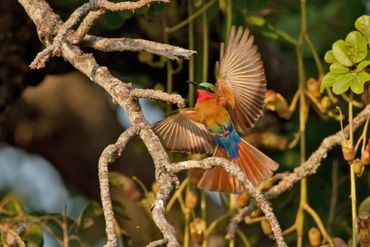
Discover the Best of Semuliki National Park
Semuliki National Park is found in western Uganda in the district of Bundibugyo which lies on Uganda’s border with DR Congo. The park is bordered by Lake Albert in the northern side and the Rwenzori Mountains on the south Eastern side. Two rivers, Lamia and Semuliki are found at the parks borders. Semuliki National Park lies on relatively flat land making it prone to flooding when the Park Rivers receive too much rain during the wet season.
Semuliki begun as a forest reserve in 1932 and was made a national park in 1993 mainly to curb deforestation. Semuliki National Park is often confused with the Semliki Wildlife Reserve which is adjacent to the park. The forests in Semuliki are an extension of the great Ituri Forest that stretches all the way to the River Zaire. This extension implies that many of the tree and animal species found in Central Africa can be found in the park. The conditions in Semuliki are completely different from any other national park in Uganda, Kenya or Tanzania but instead similar to those in central Africa.
Semuliki is well known as a top birding destination in Uganda. The park has over 410 species of birds. About 67 percent of the species are forest birds like the Blue-headed Crested Flycatcher, Capuchin Babbler, , Dwarf Honey guide, Forest Ground Thrush, , orange weaver, Purple-breasted Sunbird, Sassi’s Olive Greenbul and White-tailed Hornbill. Because the forest joins with that from DR Congo, some species unique to central Africa like the Black-wattled Hornbill, Congo Serpent Eagle, Long-tailed Hawk, Lyre-tailed Honey guide and Nkulengu Rail can be found in the park.
Experience the Wonders of Semuliki National Park
Chimpanzee tracking
Visiting the Sempaya Hot Springs
Chimpanzee tracking

The Indiana University habituated some clans of Chimpanzee that are now open for tourism. Chimpanzee tracking permits cost $30 for international visitors. While tracking the chimpanzees, visitors should also expect to spot smaller primates like the Black and white Colobus monkeys, Central African red colobus, Dent’s Mona monkeys, grey-cheeked mangabey, Olive baboons and Red-tailed monkeys among many others. It is important to come prepared with the right clothing and equipment to protect against stinging insects, sharp tree branches and thorns. Come with enough drinking water and light snack.
Bird Watching
Visiting the Sempaya Hot Springs
Chimpanzee tracking

Semuliki National Park is one of the best places for bird watching in Uganda. Semuliki National Park has half of the bird species found in the Democratic Republic of Congo because the park is an extension of the greater Ituri forest of the DR Congo which stretches up to river Zaire. This extension allows species from central Africa to move up to Semuliki National Park. Birding in the park can be done in the forest, around the Sempaya hot springs or behind the rangers post
Visiting the Sempaya Hot Springs
Visiting the Sempaya Hot Springs
Visiting the Sempaya Hot Springs

The two hot springs have made the park very famous. Tourists are more fascinated by the local stories about their formation than the scientific explanation. There is a female and male hot spring. The Male hot spring is about 12 meters in diameter and is called Bintente while the female in Nyasimbi. Boiling geyser gushes out steam and bubbling water several meters high and can be seen more than 1 kilometer away.
The water gushing out is hot enough to boil eggs in ten minutes. In the past the people living in the forest would use the hot springs to cook food but this has been limited by the park management to allow tourists visit the place. As visitors head towards the hot springs, they encounter several species of birds and small primates climbing up and down the trees.
Forest and Nature Walks
Forest and Nature Walks
Visiting the Sempaya Hot Springs

One of the popular activities in the park is taking a walk in the forest jungles to spot the vegetation, birds, butterflies and primates. Forest Walks usually begin from around the Sempaya park gate ending at the hot springs. There are three established walking trails in the park. One of them is the Sempaya Nature trail which is 8 km long, the Red-monkey track of about 11 km.
and the Kirumia Hiking trail of 13 Kilometers. Hikers need to carry rudimentary items like machete to cut overgrown vegetation as they clear paths in the forest. Visitors interested in camping in the forest need to come with their own equipment.
Game drives
Forest and Nature Walks
Game drives

Game drives in Semuliki National Park offer opportunities to spot over 52 mammals already mentioned. The park has three major tracks used for game drives that pass through the savannah plains of the park. Both day and night game drives are arranged by staff in the park. Visitors need to come with a good four wheel drive vehicle to pass through the more difficult sections of the park particularly during the rainy season.
Discover the Beauty of Semuliki National Park









Copyright © 2025 Seru Adventure Safaris - All Rights
Email: serusafaris@gmail.com